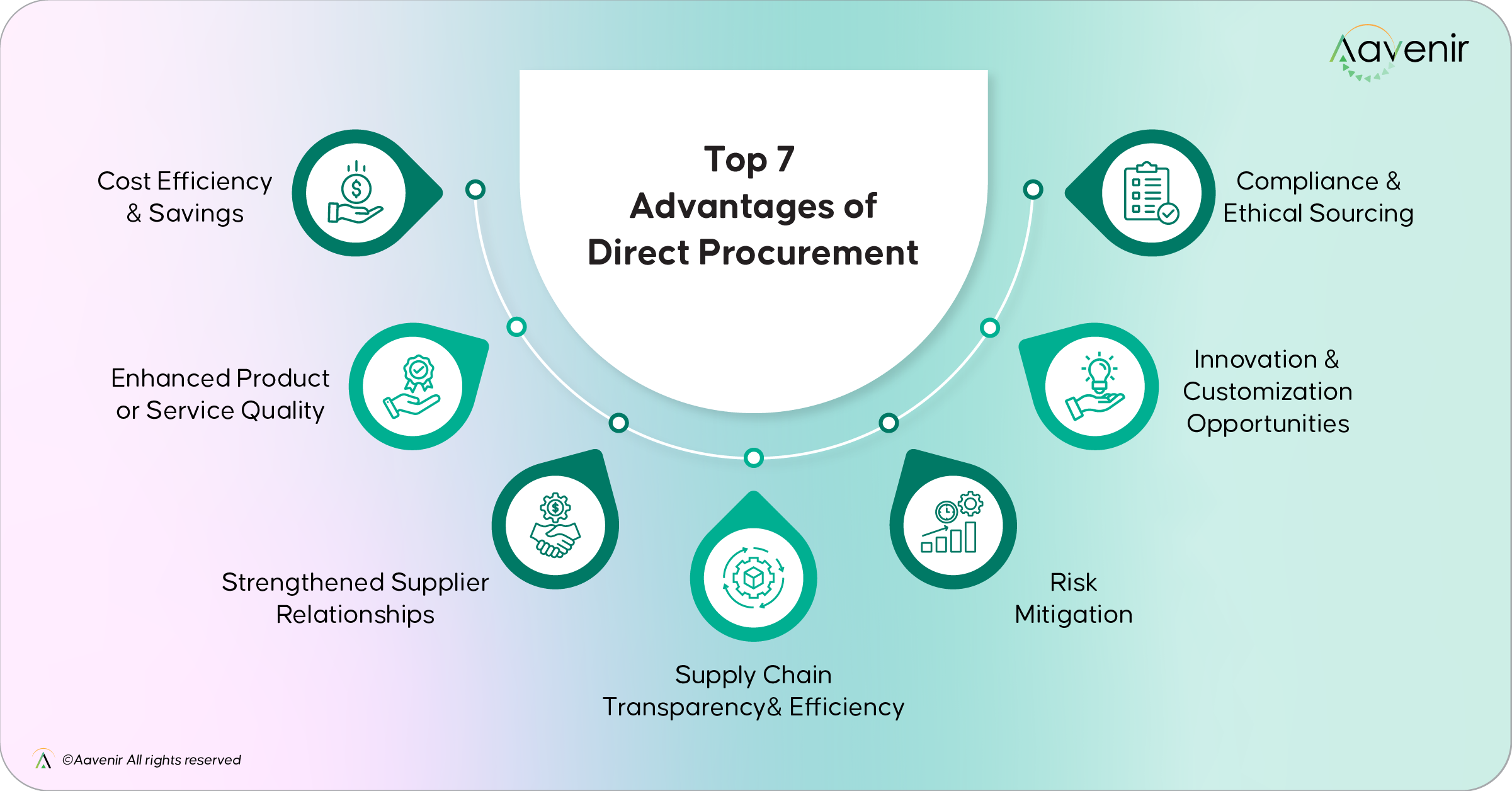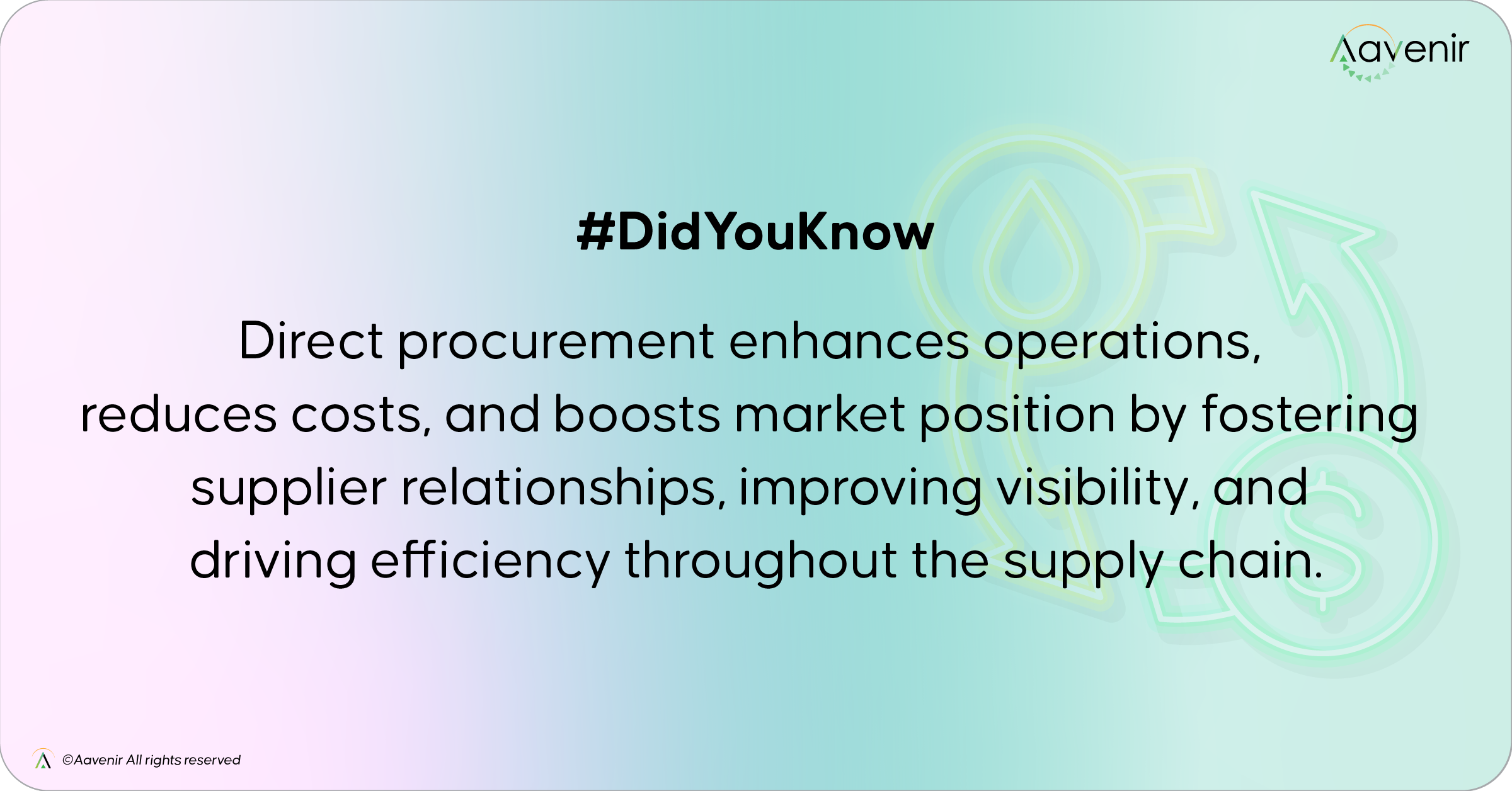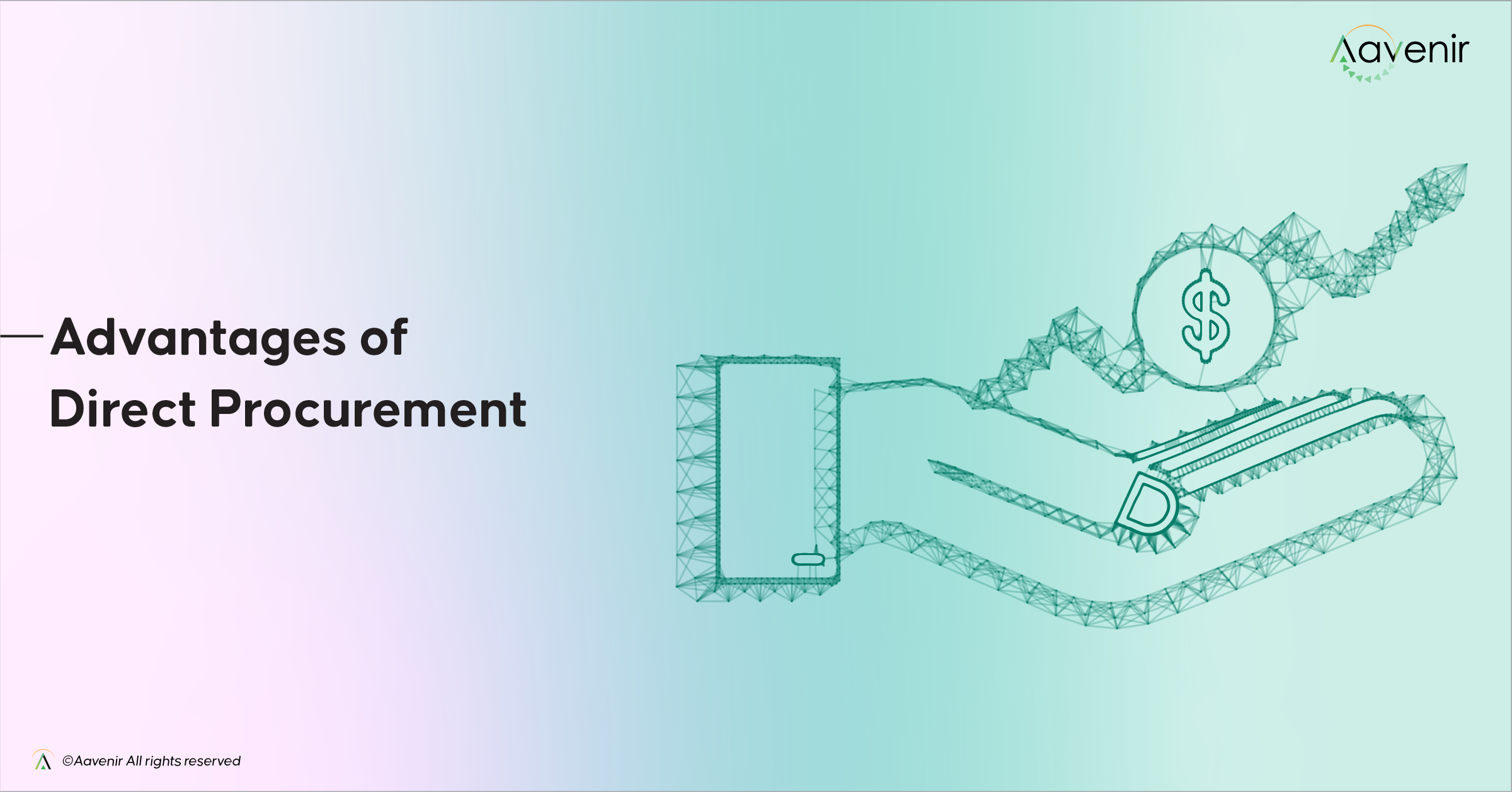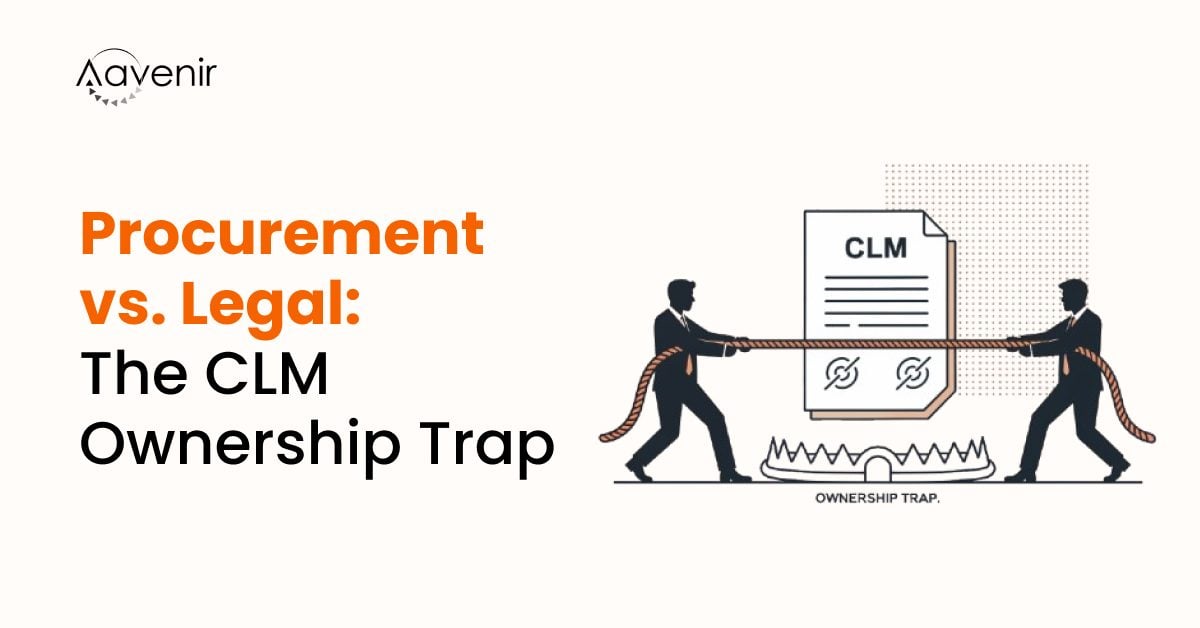Direct procurement plays a pivotal role in optimizing costs, enhancing product quality, and strengthening supply chains. By sourcing essential materials and services directly from suppliers, organizations can gain a strategic edge, turning procurement into a powerful driver of profitability and resilience.
This article delves into the 7 game-changing advantages of direct procurement and shares actionable strategies to streamline workflows using cutting-edge tools like Aavenir RFPflow.
Top 7 Advantages of Direct Procurement

1. Cost Efficiency and Savings
Direct procurement eliminates intermediaries involved in the purchase process. Companies can directly purchase from the manufacturer or supplier to avoid markups imposed by middlemen and unnecessary overhead costs in the supply chain.
Why it Matters
Organizations will only pay for the goods and services they purchase and can save a lot on commissions on intermediaries. Additionally, teams can prevent associated delays as they are the direct recipient of the product.
Consequently, teams can enjoy cost savings, translating to higher profit margins and lower per-unit costs.
How to Achieve
- Strategic Sourcing: Partner with suppliers offering the best value without compromising quality. Companies need to perform a quality control check before making a lower-cost purchase.
- Bulk Purchasing: Negotiate discounts for high-volume purchases to reduce per-unit costs. Moreover, teams can customize the raw materials or primary services to meet their needs for large orders.
- Automation: Implement procurement tools to compare RFP responses and price quotations from multiple vendors to make informed decisions and reduce manual errors.
2. Enhanced Product or Service Quality
In direct procurement, the team is directly involved in the purchase process. This will enable them to closely monitor the entire sourcing process. This visibility ensures you get what you were promised, resulting in peace of mind and operational certainty.
An added benefit is the ability to validate the quality of goods or services directly at the source. This level of visibility guarantees that you receive exactly what was promised, fostering confidence and ensuring smooth operations.
The entire purchase process is thoroughly scrutinized, facilitating the implementation of robust quality control measures. These include supplier audits and regular product or service inspections.
Why it Matters
Buyers will associate your company with a particular standard of quality unique in the marketplace, creating a distinct identity for your products and services.
Consequently, direct procurement will yield the best goods or services, improving your marketplace offerings.
How to Achieve
- Set Quality Benchmarks: Companies can communicate their quality needs and expectations early to get goods and services better suited for their processes. When the quality of raw materials or primary services remains consistent, businesses can easily create a uniform end product.
- Tight Vendor Collaboration: Direct procurement will help teams build lasting relationships with vendors and suppliers. Consequently, they can look at the partnership more favorably to always meet quality expectations.
- Innovation: Work with suppliers to improve material quality through joint research and development. More on this below.
- Continuous Monitoring: Set up a process to check the quality of goods/services received in real time. Use AI-powered tools to monitor vendor obligations and check the quality of goods/services received in real-time. Consistent vendor performance monitoring is essential for sustaining brand reputation and earning customer loyalty.
- Regulatory Compliances: Close partnerships with vendors and suppliers enable teams to meet their Environmental, Social, and Governance standards. It helps maintain adherence to additional industry-specific compliance requirements.
3. Strengthened Supplier Relationships
As mentioned earlier, direct procurement allows companies to communicate directly with their suppliers. This facilitates transparent and efficient communications that align expectations, address concerns quickly, and ensure mutual understanding.
Why it Matters
Direct procurement adds agility, as teams can address issues quickly. For example, if the order is modified due to new requirements, the RFx documents can be updated swiftly. Similarly, if there are any pressing vendor queries, they can be answered immediately.
This contributes to trust and reliability between the parties, resulting in a more resilient supply chain.
How to Achieve
- Regular Communication: Schedule periodic meetings to discuss performance, feedback, and future opportunities. Ensure the participating stakeholders have access to relevant data.
- Performance-Based Incentives: Offer rewards for suppliers meeting or exceeding expectations. Make the expectations tangible and highlight this in the contract.
- Conflict Resolution Mechanisms: Establish clear protocols for addressing disputes quickly and amicably. Train the team through workshops to prepare them in advance.
- Collaborate on a unified platform: A solution that allows you to negotiate, manage relevant documents, and track the entire direct procurement process will give suppliers everything they need.
4. Supply Chain Efficiency / Faster Time to Procure Goods/Services
Direct procurement removes middlemen and builds better relationships with vendors, which allows companies to procure goods and services faster. Teams are less likely to encounter approval or quality control bottlenecks, leading to quicker acquisition.
Why it Matters
An efficient supply chain maintains production schedules and ensures timely delivery of products or services. Companies must avoid issues like inventory holding and emergency sourcing to further reduce costs.
Delayed delivery of products or services results in slower production and dissatisfied customers. Disruptions also increase the pressure on teams to meet their obligations sooner.
The long-term advantages of procuring goods and services faster are happy customers and a strong position in the market.
How to Achieve
- Digital Procurement Platforms: Use platforms that automate order processing and tracking. Teams can take proactive measures against supply chain disruptions, such as compliance lapses or documentation issues.
- Collaborative Planning: Share production schedules with suppliers to align deliveries. This will streamline the production process and save resources during storage.
- Demand Forecasting: Use predictive analytics to anticipate material requirements. It will also allow teams to customize the raw materials or services requested to fit their production process and customer demands.
Also Read: Top Procurement Challenges of 2025 and How to Overcome Them
5. Risk Mitigation
Direct procurement unlocks transparency, which is key to identifying and mitigating potential supply chain risks. These risks include disruptions such as natural disasters, port congestion, or unexpected inventory shortages.
If teams actively communicate with vendors and suppliers, these vulnerabilities can be predicted and effectively addressed.
Why it Matters
Direct procurement enables proactive vendor risk management,[AP8] [SB9] allowing companies to navigate supply chain disruptions actively. This ensures business continuity and offers stakeholders peace of mind when things don’t go according to plan.
How to Achieve
- Risk Assessment Tools: Implement tools to identify and assess potential risks in the supply chain. The solution should notify relevant stakeholders about vulnerabilities so they can take immediate action.
- Contingency Plans: Develop backup plans for critical materials and suppliers. Inform the teams and partners in advance about these backups.
- Supplier Diversification: Companies should source from multiple suppliers in different regions to reduce dependency. This will also enable them to get the best deal available in the market.
6. Competitive Advantage with Innovation and Customization Opportunities
It is evident that teams need to improve their offerings over time. Direct procurement facilitates that by building close partnerships with suppliers. The direct engagement between the procurement department and external goods or service providers facilitates creative discussion.
Teams can leverage suppliers’ experience and expertise to gain new insights about their audience and market. In addition, companies can request tailor-made materials, components, or services to create standout offerings.
Why it Matters
Participating in direct procurement can help companies identify areas for improvement in their sourcing and production processes. They can improve everything from approval workflows to quality control to deliver quality goods/services faster while remaining cost-effective.
This translates to better offerings for the end customer, resilient operations, and an authoritative position within the industry.
Additionally, teams can remain agile to changing market dynamics and quickly adapt to evolving customer requirements.
How to Achieve
- Innovation in Procurement: Adopt cutting-edge technologies such as blockchain and AI. This will contribute to supply chain resilience and cost-effectiveness.
- Agile Processes: Continuously refine procurement workflows to adapt to market changes. Companies can develop dedicated playbooks to implement these new changes seamlessly.
- Data-Driven Insights: Use procurement analytics to identify trends and opportunities for improvement. With custom reports, every department can access the performance data they need.
7. Sustainability, Compliance, and Ethical Sourcing
Direct engagement with suppliers ensures that the product or service providers align with the company’s Environmental, Social, and Governance (ESG) standards. It is crucial for maintaining corporate integrity and meeting stakeholder expectations.
Why It Matters
Sustainable and compliant procurement enhances brand reputation and ensures compliance with legal and ethical standards. It also supports global sustainable efforts and resonates with consumers who prioritize ethical consumption.
Consequently, it enhances the organization’s Corporate Social Responsibility (CSR) profile. This demonstrates a commitment to ethical sourcing and compliance, earning consumers’ trust, investors’ support, and regulators’ approval.
How to Achieve
- Sustainability Metrics: Track the supply chain’s carbon footprint and other sustainability indicators.
- Ethical Sourcing: Partner with suppliers committed to environmentally friendly practices.
- Compliance Audits: Conduct regular audits to ensure adherence to regulatory requirements.
Implement Direct Procurement Efficiently with Aavenir

Direct procurement can significantly enhance business outcomes by lowering costs, ensuring higher-quality goods or services, and reinforcing supplier partnerships.
However, implementing a direct procurement model can pose challenges, such as inconsistent sourcing workflows, complexities in vendor onboarding, and managing contract obligations at scale.
Aavenir’s integrated suite of solutions addresses these issues and makes direct procurement frictionless. Built on the ServiceNow platform, it unifies all procurement tasks on a single interface.
Solutions like Aavenir’s RFPflow enable companies to execute their entire sourcing events, including RFx creation, response collection, RFx response scoring, vendor comparisons, negotiation, vendor selection, and more. This brings together suppliers, business teams, sourcing, and procurement teams to achieve the desired quality of products/services at the best possible costs.
Ready to elevate your direct procurement process? Contact us today for a free personalized demo.
Frequently Asked Questions
1. Why is direct procurement so important?
Direct procurement is crucial because it directly impacts production processes, cost efficiency, and product quality. It enables businesses to streamline operations, foster supplier relationships, and ensure the timely availability of essential materials and components.
2. How does direct procurement differ from indirect procurement?
Direct procurement focuses on acquiring materials and services essential for production, while indirect procurement deals with operational needs like office supplies or IT services. Unlike its operational counterpart, direct procurement is vital for manufacturing and customer-facing output.
3. Can direct procurement reduce supply chain risks?
Yes, direct procurement provides greater visibility into the supply chain, enabling proactive risk identification and mitigation. By engaging closely with suppliers, companies can more effectively address delays and compliance risks and thus ensure smoother operations.
4. What tools or software can improve direct procurement processes?
Tools like Aavenir RFPflow, Onboaardingflow, Contractflow, and Obligationflow streamline sourcing management, vendor onboarding and supplier information management, contract and compliance management. These platforms enhance transparency, improve efficiency, and simplify the procurement process, helping businesses achieve better outcomes in their supply chain management.



